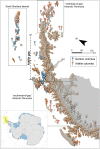Adélie penguins north and east of the 'Adélie gap' continue to thrive in the face of dramatic declines elsewhere in the Antarctic Peninsula region
- PMID: 36782007
- PMCID: PMC9923640
- DOI: 10.1038/s41598-023-29465-4
Adélie penguins north and east of the 'Adélie gap' continue to thrive in the face of dramatic declines elsewhere in the Antarctic Peninsula region
Abstract
While population declines among Adélie penguins and population increases among gentoo penguins on the Western Antarctic Peninsula are well established, the logistical challenges of operating in the sea ice-heavy northern tip of the Antarctic Peninsula have prohibited reliable monitoring of seabirds in this region. Here we describe the findings of an expedition to the northern and eastern sides of the Antarctic Peninsula-a region at the nexus of two proposed Marine Protected Areas-to investigate the distribution and abundance of penguins in this region. We discovered several previously undocumented penguin colonies, completed direct surveys of three colonies initially discovered in satellite imagery, and re-surveyed several colonies last surveyed more than a decade ago. Whereas our expectation had been that the Peninsula itself would divide the areas undergoing ecological transition and the apparently more stable Weddell Sea region, our findings suggest that the actual transition zone lies in the so-called "Adélie gap," a 400-km stretch of coastline in which Adélies are notably absent. Our findings suggest that the region north and east of this gap represents a distinct ecoregion whose dynamics stand in sharp contrast to surrounding areas and is likely to be impacted by future conservation measures.
© 2023. The Author(s).
Conflict of interest statement
The authors declare no competing interests.
Figures




Similar articles
-
Proliferation of East Antarctic Adélie penguins in response to historical deglaciation.BMC Evol Biol. 2015 Nov 18;15:236. doi: 10.1186/s12862-015-0502-2. BMC Evol Biol. 2015. PMID: 26577544 Free PMC article.
-
Marine pelagic ecosystems: the west Antarctic Peninsula.Philos Trans R Soc Lond B Biol Sci. 2007 Jan 29;362(1477):67-94. doi: 10.1098/rstb.2006.1955. Philos Trans R Soc Lond B Biol Sci. 2007. PMID: 17405208 Free PMC article. Review.
-
Multi-modal survey of Adélie penguin mega-colonies reveals the Danger Islands as a seabird hotspot.Sci Rep. 2018 Mar 2;8(1):3926. doi: 10.1038/s41598-018-22313-w. Sci Rep. 2018. PMID: 29500389 Free PMC article.
-
Projected asymmetric response of Adélie penguins to Antarctic climate change.Sci Rep. 2016 Jun 29;6:28785. doi: 10.1038/srep28785. Sci Rep. 2016. PMID: 27352849 Free PMC article.
-
Adélie penguins and temperature changes in Antarctica: a long-term view.Integr Zool. 2012 Jun;7(2):113-20. doi: 10.1111/j.1749-4877.2012.00288.x. Integr Zool. 2012. PMID: 22691195 Review.
Cited by
-
Sea ice concentration decline in an important Adélie penguin molt area.Proc Natl Acad Sci U S A. 2023 Nov 14;120(46):e2306840120. doi: 10.1073/pnas.2306840120. Epub 2023 Nov 6. Proc Natl Acad Sci U S A. 2023. PMID: 37931108 Free PMC article.
-
Availability to predators and a size structure of the Antarctic krill Euphausia superba in the 48.1 CCAMLR subarea.Sci Rep. 2024 Sep 15;14(1):21538. doi: 10.1038/s41598-024-72895-x. Sci Rep. 2024. PMID: 39278953 Free PMC article.
-
Quantifying Antarctic krill connectivity across the West Antarctic Peninsula and its role in large-scale Pygoscelis penguin population dynamics.Sci Rep. 2023 Jul 26;13(1):12072. doi: 10.1038/s41598-023-39105-6. Sci Rep. 2023. PMID: 37495764 Free PMC article.
References
-
- Fraser W, Trivelpiece W, Ainley D, Trivelpiece S. Increases in Antarctic penguin populations: Reduced competition with whales or a loss of sea ice due to environmental warming? Polar Biol. 1992;11:525–531. doi: 10.1007/BF00237945. - DOI
-
- Fraser W, Hofmann E. A predator’s perspective on causal links between climate change, physical forcing and ecosystem response. Mar. Ecol. Prog. Ser. 2003;265:1–15. doi: 10.3354/meps265001. - DOI
-
- Poncet S, Poncet J. Censuses of penguin populations of the Antarctic Peninsula, 1983–87. Br. Antarct. Surv. Bull. 1987;77:109–129.
Publication types
MeSH terms
LinkOut - more resources
Full Text Sources
Miscellaneous

